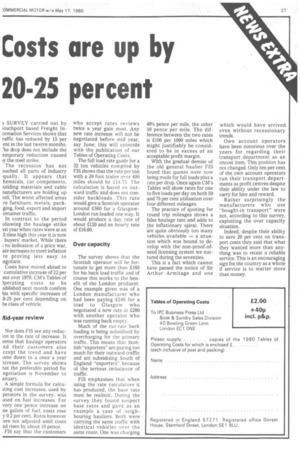Costs are up by 20-25 percent
Page 29

If you've noticed an error in this article please click here to report it so we can fix it.
SURVEY carried out by ;outhport based Freight Inormation Services shows that raffic has reduced by 15 per ent in the last twelve months. 'he drop does not include the emporary reduction caused ly the steel strike.
The recession has not ouched all parts of industry qually. It appears that hemicals, car components, iuilding materials and cable nanufacturers are holding up veil. The worst affected areas re furniture, metals, packging, food, export and import ontainer traffic.
In contrast to the period ollowing the haulage strike lst year when rates were at an 11 time high this year it is now buyers' market. While there 3 no indication of a price war, ate increases to meet inflation re proving less easy to iegotiate.
Costs have moved ahead to cumulative increase of 22 per ent over 1979. CM's Tables of )perating costs to be iublished next month confirm his with specific increases of 0-25 per cent depending on he class of vehicle.
Aid-year review Nor does FIS see any reducion in the rate of increase. It eems that haulage operators nd their customers also ccept the trend and have ome down to a once a year lcrease. The survey shows hat the preferable period for egotiation is November to anuary.
A simple formula for calcuKing cost increases, used by perators in the survey, was ased on fuel increases. For very one pence increase on ne gallon of fuel, costs rose y0.2 per cent. Rates however rere not adjusted until costs ad risen by about 10 pence.
FIS say that the customers who accept rates reviews twice a year gain most. Any new rate increase will not be negotiated before mid year, say June; this will coincide with the publication of our Tables of Operating Costs.
The full load rate guide for a 32 ton vehicles compiled by FIS shows that the rate per ton with a 20 foot trailer over 400 miles should be £14.75. The calculation is based on outward traffic and does not consider backloads. This rate would give a Scottish operator around £360 for a GlasgowLondon run loaded one way. It would produce a day rate of about £120 and an hourly rate of £16.00.
Over capacity The survey shows that the Scottish operator will be fortunate to get more than £160 for his back load traffic and of course this works to the benefit of the London producer. One example given was of a London manufacturer who had been paying £248 for a load to Glasgow who negotiated a new rate at £200 with another operator who was running back empty.
Much of the cut-rate back loading is being subsidised by overcharging for the primary traffic. This means that Scottish "exporters" are paying too much for their outward traffic and are subsidising South of England "exporters" because of the serious imbalance of traffic.
FIS emphasises that when using the .rate calculators it has produced, the base rate must be realistic. During the survey they found suspect base rates and gave as an example a case of neighbouring hauliers. Both were carrying the same traffic with identical vehicles over the same route. One was charging 491/2 pence per mile, the other 50 pence per mile. The difference between the two rates is £100 per 1000 miles which might justifiably be considered to be in excess of an acceptable profit margin.
With the gradual demise of the old general haulier FIS found that quotes were now being made for full loads plus a rate per drop. Once again CM's Tables will show rates for one to five loads per day on both 50 and 75 per cent utilisation over four different mileages.
The practice of quoting for round trip mileages shows a false haulage rate and adds to the inflationary spiral. There are quite obviously too many vehicles available — a situation which was bound to develop with the non-proof-ofneed licensing system we nurtured during the seventies.
This is a fact which cannot have passed the notice of Sir Arthur Armitage and one which would have arrived even without recessionary trends.
Own account operators have been notorious over the years for regarding their transport department as an oncost item. This position has not changed. Only ten per cent of the own account operators run their transport departments as profit centres despite their ability under the law to carry for hire and reward.
Rather surprisingly the manufacturers who use "bought-in transport" were not, according to this survey, exploiting the over capacity situation.
Indeed, despite their ability to save 20 per cent on transport costs they said that what they wanted more than anything was to retain a reliable service. This is an encouraging sign for the country as a whole if service is to matter more than money.








































































































